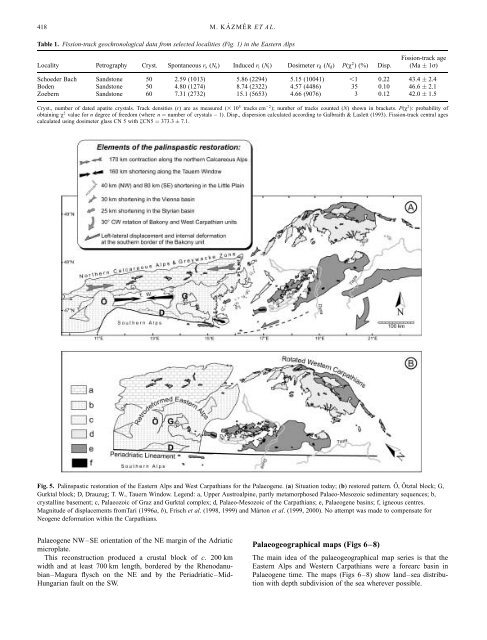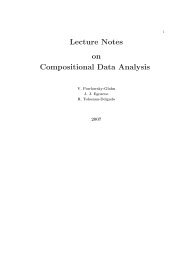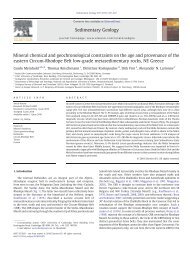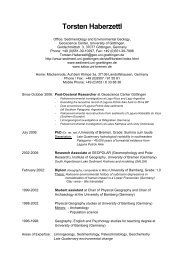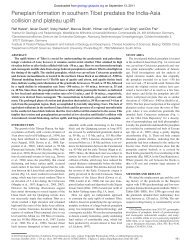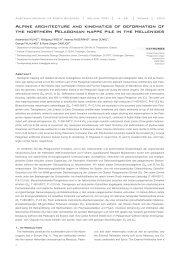The Palaeogene forearc basin of the Eastern Alps and Western ...
The Palaeogene forearc basin of the Eastern Alps and Western ...
The Palaeogene forearc basin of the Eastern Alps and Western ...
Create successful ePaper yourself
Turn your PDF publications into a flip-book with our unique Google optimized e-Paper software.
418<br />
M. KÁZMÉR ET AL.<br />
Table 1. Fission-track geochronological data from selected localities (Fig. 1) in <strong>the</strong> <strong>Eastern</strong> <strong>Alps</strong><br />
Locality Petrography Cryst. Spontaneous r s (N s ) Induced r i (N i ) Dosimeter r d (N d ) P(÷ 2 ) (%) Disp.<br />
Fission-track age<br />
(Ma 1ó)<br />
Schoeder Bach S<strong>and</strong>stone 50 2.59 (1013) 5.86 (2294) 5.15 (10041) ,1 0.22 43.4 2.4<br />
Boden S<strong>and</strong>stone 50 4.80 (1274) 8.74 (2322) 4.57 (4486) 35 0.10 46.6 2.1<br />
Zoebern S<strong>and</strong>stone 60 7.31 (2732) 15.1 (5653) 4.66 (9076) 3 0.12 42.0 1.5<br />
Cryst., number <strong>of</strong> dated apatite crystals. Track densities (r) are as measured (3 10 5 tracks cm 2 ); number <strong>of</strong> tracks counted (N) shown in brackets. P(÷ 2 ): probability <strong>of</strong><br />
obtaining ÷ 2 value for n degree <strong>of</strong> freedom (where n ¼ number <strong>of</strong> crystals 1). Disp., dispersion calculated according to Galbraith & Laslett (1993). Fission-track central ages<br />
calculated using dosimeter glass CN 5 with æCN5 ¼ 373:3 7:1.<br />
Fig. 5. Palinspastic restoration <strong>of</strong> <strong>the</strong> <strong>Eastern</strong> <strong>Alps</strong> <strong>and</strong> West Carpathians for <strong>the</strong> <strong>Palaeogene</strong>. (a) Situation today; (b) restored pattern. Ö, Ötztal block; G,<br />
Gurktal block; D, Drauzug; T. W., Tauern Window. Legend: a, Upper Austroalpine, partly metamorphosed Palaeo-Mesozoic sedimentary sequences; b,<br />
crystalline basement; c, Palaeozoic <strong>of</strong> Graz <strong>and</strong> Gurktal complex; d, Palaeo-Mesozoic <strong>of</strong> <strong>the</strong> Carpathians; e, <strong>Palaeogene</strong> <strong>basin</strong>s; f, igneous centres.<br />
Magnitude <strong>of</strong> displacements fromTari (1996a, b), Frisch et al. (1998, 1999) <strong>and</strong> Márton et al. (1999, 2000). No attempt was made to compensate for<br />
Neogene deformation within <strong>the</strong> Carpathians.<br />
<strong>Palaeogene</strong> NW–SE orientation <strong>of</strong> <strong>the</strong> NE margin <strong>of</strong> <strong>the</strong> Adriatic<br />
microplate.<br />
This reconstruction produced a crustal block <strong>of</strong> c. 200 km<br />
width <strong>and</strong> at least 700 km length, bordered by <strong>the</strong> Rhenodanubian–Magura<br />
flysch on <strong>the</strong> NE <strong>and</strong> by <strong>the</strong> Periadriatic–Mid-<br />
Hungarian fault on <strong>the</strong> SW.<br />
Palaeogeographical maps (Figs 6–8)<br />
<strong>The</strong> main idea <strong>of</strong> <strong>the</strong> palaeogeographical map series is that <strong>the</strong><br />
<strong>Eastern</strong> <strong>Alps</strong> <strong>and</strong> <strong>Western</strong> Carpathians were a <strong>forearc</strong> <strong>basin</strong> in<br />
<strong>Palaeogene</strong> time. <strong>The</strong> maps (Figs 6–8) show l<strong>and</strong>–sea distribution<br />
with depth subdivision <strong>of</strong> <strong>the</strong> sea wherever possible.


